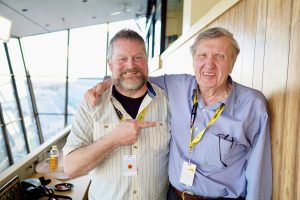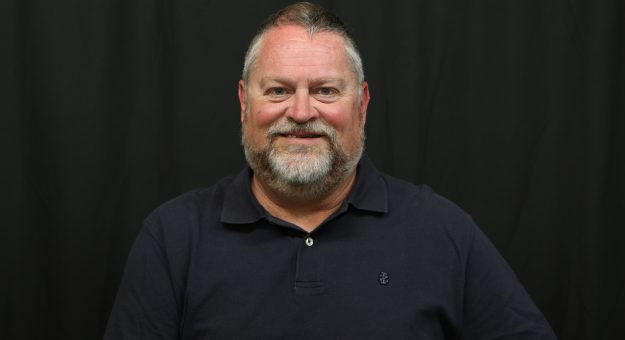DAYTONA BEACH, Fla. — The annual trek to the Daytona 500 is a chance for reflection, while also looking ahead to hopefully a brighter future. Although in the news business work never takes a break, the Daytona 500 signals that it’s time to get back on the road and start chasing down stories.
It’s also a chance to visit with old friends. For years, one of those friends was Ken Squier.
To millions of NASCAR fans, he was the voice of the Daytona 500. The person who introduced them to the sport.
Squier was the man at the microphone who called the incredibly dramatic 1979 Daytona 500 on CBS, the first time the race had been shown live, flag-to-flag, on a major network.
 Prior to that, the 1960 Daytona 500 was televised on the “CBS Sports Spectacular” with legendary sportscaster Bud Palmer at the mic.
Prior to that, the 1960 Daytona 500 was televised on the “CBS Sports Spectacular” with legendary sportscaster Bud Palmer at the mic.
Beginning in 1962, the Daytona 500 began a 16-year run on ABC. Jim McKay called the action that year with Stirling Moss doing the color commentary and SPEED SPORT’s Chris Economaki as the man in the pits. It was filmed, edited and shown the following week on ABC’s “Wide World of Sports.”
Some of the great names in television broadcasting history called the Daytona 500, including Bill Flemming, Curt Gowdy, Keith Jackson and McKay on ABC.
In 1974, as the Daytona 500 had long since established itself as NASCAR’s premier race, ABC often televised the start, would break away to other programming, and then return for the final half of the race on live TV.
The last year for that arrangement was 1978 with McKay, Jackie Stewart and Economaki providing the voices for the first of Bobby Allison’s three Daytona 500 wins.
But it was Squier who played a role in perhaps the most defining moment in NASCAR history in 1979, which has been called by many as a “Perfect Storm.”
A major blizzard buried most of the northern United States that weekend including Bloomington, Ind. That’s where a sophomore at Indiana University watched with wonder the Daytona 500 on his 12-inch, black-and-white RCA TV from the 11th floor dorm room of Willkie South.
Snow drifts of 30 inches gave IU college students yet another excuse to party, like they ever needed an excuse for that. So as this college student shook off the effects of too much partying from the night before, the 1979 Daytona 500 seemed like a good diversion to regain a sense of normalcy and balance.
The finish of the 1979 Daytona 500 was compelling, edge-of-your-seat chaos.
Squier, with his dramatic delivery and colorful vocabulary, was already an established network sportscaster on CBS.
The Vermont native co-founded the Motor Racing Network with NASCAR founder Bill France in 1970. He was the voice of Long Beach Grand Prix on “CBS Sports Spectacular” in 1975 when it was a Formula 5000 race and again in 1976 when it was on the Formula 1 schedule.
The combination of a blizzard that created a captive audience for CBS’ live coverage of the Daytona 500, and a thrilling finish that ended with a fist-fight between Cale Yarborough and Allison after Yarborough wrecked Donnie Allison on the final lap put NASCAR on the front page of the New York Times.
It also made Squier an even bigger star than he already was.
That student at Indiana University eventually graduated with a degree in journalism and began a career as a sportswriter that took him to the 1983 Daytona 500.
CBS was the major player in NASCAR television with the Daytona 500 as its star attraction, but ESPN was the network that televised NASCAR on a weekly basis.
By the time CBS ended its 21-year run as the television home of the Daytona 500, Squier had become the host of the telecast, yielding the race call to Mike Joy.
As a voice from my youth, I became friends with Squier. Another voice from my youth was Economaki, and I had the honor of working for him at National Speed Sports News in 1993.
Journalists could learn a lot from people like Economaki and Squier.
As time went by, Squier and I became friends. It wasn’t an official Daytona 500 until Squier would come wandering in the Benny Kahn media center at Daytona Int’l Speedway looking for the starting lineup.
After his CBS days, we began an annual tradition of going to Billy’s Tap Room in Ormond Beach, Fla., the night before the Daytona 500. Stacie Fandel Cooper became part of that group and we would sit around and be entertained by Squier.
The night would always culminate with Squier’s famed “Gladys Gooding” story. No matter how many times we heard that story, Squier’s delivery always left us howling with laughter.
Squier also made a regular habit of sitting next to me in the Houston Lawing Press Box to watch the Daytona 500 on race day.
Around 2018 or 2019, the annual gathering fizzled away. Then COVID-19 hit in 2020. By the end of that year, Squier came down with COVID. Although he recovered, it set him back. He did not attend the Daytona 500 in 2021 or ’22.
I tried to call Squier during that time, but only got his voice mail. After a while, we lost touch.
It was at the annual NMPA Convention in Concord, N.C., during January that one of Squier’s many proteges, broadcaster Dave Moody, told us he talks to Squier on the phone every week.
The following day, I called Squier and he answered.
The 88-year-old was eating dinner and said he would call back. About an hour later, my phone rang.
We talked for about an hour, told old stories. Squier doesn’t remember the Gladys Gooding story, but he was very inquisitive and interested in what was happening in NASCAR.
“I’m not in any condition to go to Daytona this year, but I plan on making it back next year,” Squier told me.
I told him we would plan on it and I would save him a seat at Billy’s Tap Room the night before the 2024 Daytona 500.
Reconnecting with an old friend provided a chance to reflect on this long journey, from a groggy Indiana University student watching the 1979 Daytona 500 on a black-and-white TV being called by one of the voices of my youth.
Friends like Ken Squier have helped make that journey well worth it.
This story appeared in the March 8, 2023 edition of the SPEED SPORT Insider.

